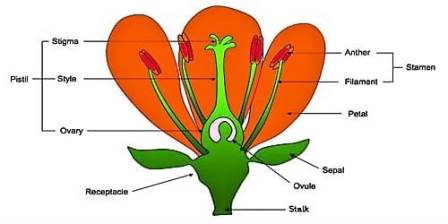Parts of Flower











Parts of Flower
Most flowers have both the male and female reproductive organs, but some bear either the male or the female sex organs. Such flowers are known as unisexual flowers (e.g., watermelon, cucumber, etc.) Those flowers which have both sex organs are known as bisexual flowers (e.g., Hibiscus, pea, etc.) A flower generally bears a long or short axis. This axis has two parts—the stalk of the flower, called pedicel, and its swollen top called thalamus. The parts of a flower are arranged on the thalamus. A typical flower consists of four sets of floral parts, or whorls: calyx (sepals), corolla (petals), androecium (stamens) and gynoecium (carpels). Calyx and corolla are not directly involved in reproduction. Androecium and gynoecium are directly concerned with sexual reproduction. The androecium is the male part of the flower and consists of stamens. The gynoecium (or pistil) consists of carpels and is the female reproductive part. The whorls are arranged on the thalamus of a flower in a definite sequence.
Calyx: Calyx is the outermost whorl. It consists of sepals. The sepals are usually green, but sometimes they may be coloured. Calyx protects the floral whorls in the bud stage.
Corolla: Corolla, the next inner whorl, consists of petals. Petals may be white or brightly coloured. They attract insects towards the flower and thus help in pollination. Corolla protects the reproductive whorls in the bud stage.
Androecium: The stamens are collectively called androecium, which is the third whorl. Each stamen consists of a filament and an anther. Each anther has two chambers called pollen sacs. If you touch the stamens of a flower, a yellowish powder may come off on your hands. Anthers produce these numerous yellowish pollen grains, which contain male gametes.
Gynoecium: The gynoecium (or pistil) is in the centre of the flower. It is the fourth whorl. It bears the female reproductive organ, called carpel. Each carpel consists of three parts—a basal swollen portion called ovary, a narrow stalkdike middle portion called style and a one- to many-lobed flattened disc like sticky structure called stigma at the top of the style.The ovary is surrounded by an outer wall. The ovary may be divided into chambers. The chambers contain ovules. Each ovule has an egg cell (female gamete).

Match colomn - I with Column select the correct answer using codes given below the columns.
| |||||||
| Right Option : C | |||||||
| View Explanation | |||||||
The anther contains __________________ | |||
| Right Option : D | |||
| View Explanation | |||
In a rose flower, we find | |||
| Right Option : A | |||
| View Explanation |
Students / Parents Reviews [10]
It was good as the experience because as we had come here we had been improved in a such envirnment created here.Extra is taught which is beneficial for future.

Eshan Arora
8thI have spent a wonderful time in Abhyas academy. It has made my reasoning more apt, English more stronger and Maths an interesting subject for me. It has given me a habbit of self studying

Yatharthi Sharma
10thAbout Abhyas metholodology the teachers are very nice and hardworking toward students.The Centre Head Mrs Anu Sethi is also a brilliant teacher.Abhyas has taught me how to overcome problems and has always taken my doubts and suppoeted me.

Shreya Shrivastava
8thIt was a good experience with Abhyas Academy. I even faced problems in starting but slowly and steadily overcomed. Especially reasoning classes helped me a lot.

Cheshta
10thOne of the best institutes to develope a child interest in studies.Provides SST and English knowledge also unlike other institutes. Teachers are co operative and friendly online tests andPPT develope practical knowledge also.

Aman Kumar Shrivastava
10thIt has a great methodology. Students here can get analysis to their test quickly.We can learn easily through PPTs and the testing methods are good. We know that where we have to practice

Barkha Arora
10thA marvelous experience with Abhyas. I am glad to share that my ward has achieved more than enough at the Ambala ABHYAS centre. Years have passed on and more and more he has gained. May the centre flourish and develop day by day by the grace of God.

Archit Segal
7thAbhyas Methodology is very good. It is based on according to student and each child manages accordingly to its properly. Methodology has improved the abilities of students to shine them in future.

Manish Kumar
10thAbhyas is a complete education Institute. Here extreme care is taken by teacher with the help of regular exam. Extra classes also conducted by the institute, if the student is weak.

Om Umang
10thMy experience with Abhyas is very good. I have learnt many things here like vedic maths and reasoning also. Teachers here first take our doubts and then there are assignments to verify our weak points.
